
Drones have transformed how we capture aerial footage, explore landscapes, and even conduct business. With their rise in popularity, understanding the regulations governing their use is critical for safe and legal flying. A common misconception is that drones weighing less than 250 grams (0.55 pounds) are entirely exempt from regulations in the United States. As of June 2025, this is only partially true. This comprehensive guide explores the Federal Aviation Administration (FAA) rules for sub-250g drones, covering both recreational and commercial use, and clarifies the role of Remote ID and other operational requirements.
Why Sub-250g Drones Are Popular
Sub-250g drones, like the DJI Mini 3 Pro, are favored for their portability and lightweight design, making them ideal for hobbyists, travelers, and professionals. Their small size often leads to the assumption that they face fewer regulatory restrictions. While there are some exemptions, most FAA operational rules still apply, ensuring safety in the National Airspace System (NAS).
Regulations for Recreational Drone Flying
For recreational pilots—those flying drones purely for enjoyment and not for business purposes—sub-250g drones come with specific exemptions but also responsibilities. Here’s a detailed breakdown:
- No Registration Required: Drones weighing less than 250 grams at takeoff do not need to be registered with the FAA when flown recreationally, as outlined on the [FAA’s registration page] (https://www.faa.gov/uas/getting_started/register_drone).
- No Remote ID Required: Since Remote ID is tied to registration, sub-250g recreational drones are exempt from this requirement, as confirmed by sources like [Pilot Institute] (https://pilotinstitute.com/remote-id-is-here-what-you-need-to-know/) and [The Drone Girl] (https://www.thedronegirl.com/2023/04/21/is-your-drone-flight-remote-id-compliant/).
- Operational Rules Apply: Despite these exemptions, all other FAA regulations for drones under 55 pounds apply, with no lower weight limit. These rules ensure safe integration into the airspace and include:
- Altitude Limit: Fly below 400 feet above ground level (AGL) or the maximum height allowed by LAANC (Low Altitude Authorization and Notification Capability) in controlled airspace.
- Airspace Authorization: Use LAANC to get authorization for flying in controlled airspace, such as near airports.
- Visual Observer for FPV: If flying First Person View (FPV), have a co-located visual observer who can see the drone at all times.
- Airspace Restrictions: Adhere to Temporary Flight Restrictions (TFRs) and Notices to Airmen (NOTAMs).
- Safety Precautions:
- Never fly near other aircraft.
- Always yield to manned aircraft.
- Do not fly over groups of people.
- Avoid flying near emergency response activities.
- Never fly under the influence of drugs or alcohol.
- TRUST Test: Recreational flyers are encouraged to take the Recreational UAS Safety Test (TRUST), a free test to ensure knowledge of safe flying practices. Proof of passage must be carried when flying, as noted on the [FAA’s recreational flyers page] (https://www.faa.gov/uas/recreational_flyers).
Important Note: The 250g weight limit refers to the takeoff weight. Adding accessories like propeller guards or larger batteries can push a drone over 250g, requiring registration and Remote ID compliance.
Regulations for Commercial Drone Flying (Part 107)
For commercial operations—flying drones for business purposes, such as photography or inspections—the rules are stricter, regardless of drone weight. Here’s what you need to know:
- Registration Required: All drones used for commercial purposes must be registered with the FAA, even if they weigh less than 250g. Registration costs $5 per drone and is valid for three years, as per the [FAA’s registration guidelines] (https://www.faa.gov/uas/getting_started/register_drone).
- Remote ID Mandatory: Since registration is required, all commercial drones must comply with Remote ID rules, broadcasting identification and location data during flight.
- Part 107 Certification: Pilots must obtain a Remote Pilot Certificate by passing the Part 107 exam, which covers airspace rules, safety protocols, and more, as detailed by [Pilot Institute] (https://pilotinstitute.com/sub-250-part-107/).
- Operational Rules: Commercial pilots must adhere to Part 107 regulations, which include restrictions on flying over people, night operations, and maintaining visual line-of-sight, among others.
Even a 50g drone used for commercial purposes must meet these requirements, making Part 107 compliance essential for professional pilots.
What is Remote ID?
Remote ID is a digital identification system, often compared to a “license plate” for drones. It broadcasts real-time data, including the drone’s identity, location, altitude, and control station details, to enhance safety and accountability. Implemented by the FAA in September 2023, Remote ID is mandatory for all registered drones, as explained on the [FAA’s Remote ID page] (https://www.faa.gov/uas/getting_started/remote_id). For recreational sub-250g drones, this requirement does not apply unless the drone exceeds 250g with accessories. However, many modern drones, like the DJI Mini 3 Pro, have built-in Remote ID that may broadcast automatically, even if not required for recreational use.
Comparison of Regulations for Sub-250g Drones
| Aspect | Recreational Use | Commercial Use (Part 107) |
|---|---|---|
| Registration | Not required if under 250g | Required for all drones |
| Remote ID | Not required if under 250g | Mandatory |
| Operational Rules | Must follow all FAA rules (e.g., 400ft AGL, LAANC) | Must follow Part 107 rules |
| Pilot Certification | TRUST test recommended | Remote Pilot Certificate required |
Tips for Compliant Drone Flying
- Check Weight: Ensure your drone’s takeoff weight, including accessories, is under 250g for recreational exemptions.
- Stay Informed: Regularly visit the [FAA’s UAS page] (https://www.faa.gov/uas) for updates, as regulations can change.
- Use Apps: Apps like B4UFLY help identify airspace restrictions and ensure compliance.
- Take TRUST: Complete the free TRUST test to understand safety protocols, available through FAA-approved providers.
- Plan Flights: Avoid restricted areas and check for TFRs or NOTAMs before flying.
Conclusion
Sub-250g drones offer flexibility for recreational pilots, with exemptions from registration and Remote ID requirements as of June 2025. However, all other FAA operational rules, such as altitude limits and airspace restrictions, remain in effect to ensure safety. For commercial pilots, no weight-based exemptions exist—registration, Remote ID, and Part 107 compliance are mandatory. By understanding these rules and staying updated via the [FAA’s website] (https://www.faa.gov/uas), drone pilots can enjoy their hobby or profession safely and legally. Ready to fly? Check your drone’s weight and local regulations before taking off!




1 Comment
Kevin
The Comparison of Regulations for Sub-250g Drones is GREAT! Thanks